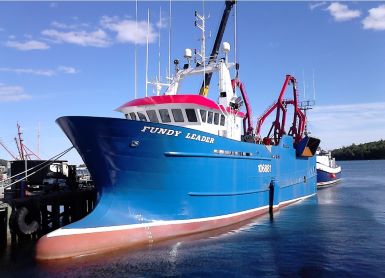
A 30cm crack along the main engine exhaust silencer led to a fire on board scallop fishing vessel Fundy Leader, according to the Transportation Safety Board of Canada (TSB).
What happened
On 06 December 2024, the fishing vessel Fundy Leader, with 13 people on board, was reported having sustained a fire 100 nautical miles southwest of Cape Sable, Nova Scotia. The crew extinguished the fire, and the vessel was escorted to Shelburne, Nova Scotia, by the Atlantic Preserver, and later by the Canadian Coast Guard ship Sir William Alexander. There were no injuries.
Origin of the fire
Data collected post-occurrence indicated that the source of ignition originated from a crack in the main engine exhaust silencer. The crack was approximately 30 cm in length and near the top of the silencer, on the side that faced the bulkhead separating the exhaust trunking from the cabin. Low‑flame‑spread wall panelling was attached to the wood framing on the side of the bulkhead facing the cabin.
In this occurrence, hot exhaust gases were escaping from the cracked silencer and heating up the steel on the bulkhead, which was less than 10 cm away. By conduction, the heated steel ignited the wood framing and caused the fire.
Structural fire protection
The Large Fishing Vessel Inspection Regulations require certain areas of large fishing vessels to have low‑flame‑spread characteristics.
The Fundy Leader met the requirements of the Large Fishing Vessel Inspection Regulations for low‑flame‑spread characteristics.
Inspecting exhaust pipes
The main engine exhaust pipe (including the silencer) was covered with a type of lagging that could not be removed without damaging the lagging. The pipe was located next to a generator exhaust pipe. Both pipes were in a small area adjacent to the bulkhead, which meant that it was difficult to visually inspect the entire circumference of either. Exhaust trunking on fishing vessels typically provides limited access to exhaust pipes.
Large fishing vessels like the Fundy Leader fall under Transport Canada’s Delegated Statutory Inspection Program and are subject to periodic inspections by recognized organizations. At the time of the occurrence, the Fundy Leader was certified by the recognized organization Lloyd’s Register, on behalf of Transport Canada. Exhaust pipes and silencers may be inspected by recognized organizations for signs of damage, leaks, and degradation, but this is typically limited to a visual inspection without removing the lagging. The last inspection conducted by the recognized organization was on 15 October 2024. During this inspection, the exhaust pipes and silencers were observed to have intact lagging.
It was not possible to determine how long the crack in the silencer had been present on the Fundy Leader prior to the occurrence. Some signs of a crack in a silencer may include visible discolouration of lagging or increases in noise, exhaust odours, or heat. The master and the crew members on the Fundy Leader were unaware of the crack in the silencer before the occurrence. The silencer was original to the construction of the vessel.
Safety action taken
Following the occurrence, Clearwater Seafoods instructed the master of the Fundy Leader to check the temperature of the exhaust pipes and trunking with an infrared thermometer during each voyage.
The sections of exhaust lagging damaged in the fire were replaced with a type of lagging that can be removed for inspections by vessel crew and regulators.
During vessel repairs post-occurrence, the company that owns and operates the Fundy Leader removed the remaining wood framing in the bulkheads separating the cabin and galley from the exhaust trunking. Metal framing was installed in its place. The wooden fire axe handles were replaced with fibreglass handles.
Safety messages
The TSB routinely communicates that meeting regulatory requirements ensures only a minimum level of safety. Even though regulations permit structures around exhaust trunking on fishing vessels to be constructed of combustible materials, vessel builders and owners must consider whether this is safe for their vessel. Where possible, combustible materials should be eliminated and, if they cannot be eliminated, must be protected from potential fire hazards.
Vessel exhaust pipes and silencers may pose a fire hazard in the event they sustain cracks or other failures. It is important that vessel owners and masters ensure these pipes and silencers are inspected and maintained regularly and that vessel builders design exhaust trunking and lagging to facilitate access to pipes and silencers for inspection and maintenance.
Read the report: TSB investigation - Fundy Leader